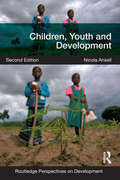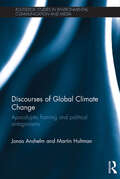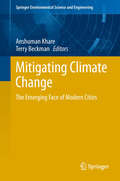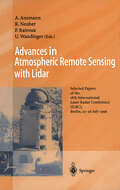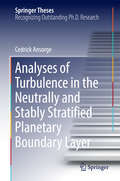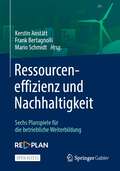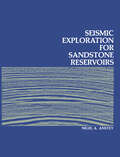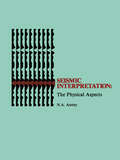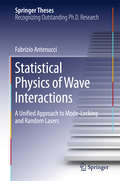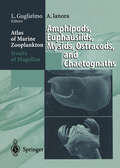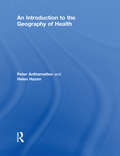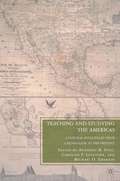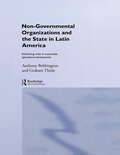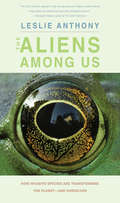- Table View
- List View
Children, Youth and Development (Routledge Perspectives on Development)
by Nicola AnsellThe new updated edition of Children, Youth and Development explores the varied ways in which global processes in the form of development policies, economic and cultural globalisation, and international agreements interact with more locally specific practices to shape the lives of young people living in the poorer regions of the world. It examines these processes, and the effects they have on young people’s lives, in relation to developing theoretical approaches to the study of children and youth.? This landmark title brings together the stock of knowledge and approaches to understanding young people’s lives in the context of development and globalization in the majority world for the first time. It introduces different theoretical approaches to the study of young people, and explores the ways in which these, along with predominantly Western conceptions of childhood and youth, have influenced how majority world children have been viewed and treated by international agencies. Contexts of globalisation and growing international inequality are explored, alongside more immediate contexts such as family and peer relationships. Chapters are devoted to groups of children deemed to be in need of protection and to debates concerning children’s rights and their participation in development projects. Young people’s health and education are considered, as is their involvement in work of various kinds, and the impacts of environmental change and hazards (including climate change). The book introduces material and concepts to readers in a very accessible way and within each chapter employs features such as boxed case studies, summaries of key ideas, discussion questions and guides to further resources. This edition has been updated to take account of significant changes in the contexts in which poor children grow up, notably the financial crisis and changing development policy environment, as well as recent theoretical developments. It is aimed at students on higher level undergraduate and postgraduate courses, as well as researchers who are unfamiliar with this area of research and practitioners in organisations working to ameliorate the lives of children in majority world countries.
Discourses of Global Climate Change: Apocalyptic framing and political antagonisms (Routledge Studies in Environmental Communication and Media)
by Jonas Anshelm Martin HultmanThis book examines the arguments made by political actors in the creation of antagonistic discourses on climate change. Using in-depth empirical research from Sweden, a country considered by the international political community to be a frontrunner in tackling climate change, it draws out lessons that contribute to the worldwide environmental debate. The book identifies and analyses four globally circulated discourses that call for very different action to be taken to achieve sustainability: Industrial fatalism, Green Keynesianism, Eco-socialism and Climate scepticism. Drawing on risk society and post-political theory, it elaborates concepts such as industrial modern masculinity and ecomodern utopia, exploring how it is possible to reconcile apocalyptic framing to the dominant discourse of political conservatism. This highly original and detailed study focuses on opinion leaders and the way discourses are framed in the climate change debate, making it valuable reading for students and scholars of environmental communication and media, global environmental policy, energy research and sustainability.
Discourses of Global Climate Change: Apocalyptic framing and political antagonisms (Routledge Studies in Environmental Communication and Media)
by Jonas Anshelm Martin HultmanThis book examines the arguments made by political actors in the creation of antagonistic discourses on climate change. Using in-depth empirical research from Sweden, a country considered by the international political community to be a frontrunner in tackling climate change, it draws out lessons that contribute to the worldwide environmental debate. The book identifies and analyses four globally circulated discourses that call for very different action to be taken to achieve sustainability: Industrial fatalism, Green Keynesianism, Eco-socialism and Climate scepticism. Drawing on risk society and post-political theory, it elaborates concepts such as industrial modern masculinity and ecomodern utopia, exploring how it is possible to reconcile apocalyptic framing to the dominant discourse of political conservatism. This highly original and detailed study focuses on opinion leaders and the way discourses are framed in the climate change debate, making it valuable reading for students and scholars of environmental communication and media, global environmental policy, energy research and sustainability.
Mitigating Climate Change: The Emerging Face of Modern Cities (Springer Environmental Science and Engineering)
by Anshuman Khare and Terry BeckmanWith ever increasing trends in urban consumption and production practices, a call for action to mitigate Climate Change is often seen as a way to foster sustainable development. Considerable attention is now being paid to determine what urban sustainability would include. Today there is a pressing need to broaden our knowledge and apply new concepts and frameworks to development of modern cities. Building on the foregoing, this book attempts to bring together and discuss concepts, tools, frameworks and best practices to cope with the emerging challenges faced by cities today. The book will be of use to policy makers, city planners, practitioners and academics who are starting to project what modern cities would need to do in terms of energy efficiency, mobility, planning and design of habitat and infrastructure and adapting to climate change.
Advances in Atmospheric Remote Sensing with Lidar: Selected Papers of the 18th International Laser Radar Conference (ILRC), Berlin, 22–26 July 1996
by Albert Ansmann Roland Neuber Patrick Rairoux Ulla WandingerLidar or laser radar, the depth-resolved remote measurement of atmospheric parameters with optical means, has become an important tool in the field of atmospheric and environmental remote sensing. In this volume the latest progress in the development of Lidar methods, experiments, and applications is described. The content is based on selected and thoroughly refereed papers presented at the 18th International Laser Radar Conference, Berlin, 22 - 26 July 1996. The book is divided into six parts which cover the topics of tropospheric aerosols and clouds, Lidar in space, wind, water vapor, troposheric trace gases and plumes, and stratospheric and mesospheric profiling. As a supplement to fundamental LIDAR textbooks this volume may serve as a guide through the blossoming field of modern Lidar techniques.
Analyses of Turbulence in the Neutrally and Stably Stratified Planetary Boundary Layer (Springer Theses)
by Cedrick AnsorgeThis thesis presents a study of strong stratification and turbulence collapse in the planetary boundary layer, opening a new avenue in this field. It is the first work to study all regimes of stratified turbulence in a unified simulation framework without a break in the paradigms for representation of turbulence. To date, advances in our understanding and the parameterization of turbulence in the stable boundary layer have been hampered by difficulties simulating the strongly stratified regime, and the analysis has primarily been based on field measurements. The content presented here changes that paradigm by demonstrating the ability of direct numerical simulation to address this problem, and by doing so to remove the uncertainty of turbulence models from the analysis. Employing a stably stratified Ekman layer as a simplified physical model of the stable boundary layer, the three stratification regimes observed in nature— weakly, intermediately and strongly stratified—are reproduced, and the data is subsequently used to answer key, long-standing questions. The main part of the book is organized in three sections, namely a comprehensive introduction, numerics, and physics. The thesis ends with a clear and concise conclusion that distills specific implications for the study of the stable boundary layer. This structure emphasizes the physical results, but at the same time gives relevance to the technical aspects of numerical schemes and post-processing tools. The selection of the relevant literature during the introduction, and its use along the work appropriately combines literature from two research communities: fluid dynamics, and boundary-layer meteorology.
Ressourceneffizienz und Nachhaltigkeit: Sechs Planspiele für die betriebliche Weiterbildung
by Kerstin Anstätt Frank Bertagnolli Mario SchmidtKlimaschutz und Ressourceneffizienz gehen häufig Hand in Hand. Mit Spiel und Spaß ressourceneffizientes Handeln fördern – das ist die Devise der Planspiele rund um das Thema Energie- und Materialeffizienz, die in diesem Buch vorgestellt werden. Die Planspiele schließen eine Lücke im betrieblichen Weiterbildungsangebot und bilden ein niederschwelliges Angebot, mit dem ressourceneffizientes Denken und Handeln spielerisch in Unternehmen eingeführt werden kann. Unternehmen aller Art können gleich auf mehrere Arten von den in den Spielen vermittelten Kenntnissen und Methoden profitieren: Durch Ressourceneffizienz-Maßnahmen werden sowohl deutliche Kosteneinsparungen erzielt als auch ein Beitrag zum Klimaschutz durch die Minderung von Treibhausgasemissionen geleistet. Dies wirkt sich nicht zuletzt positiv auf die Wettbewerbs- und die Innovationsfähigkeit aus. Darüber hinaus werden die Mitarbeiter intern mit einem attraktiven und kurzweiligen Schulungsangebot weiterqualifiziert. Die Interaktion im Spiel involviert die Mitarbeiter aktiv und motiviert sie, ihr Wissen produktiv einzubringen. Das Ergebnis sind neue Ideen für noch mehr Effizienz im Unternehmen und gleichzeitig für mehr Klimaschutz. In diesem Open Access-Buch werden sowohl das fachliche Hintergrundwissen für die in den Spielen vermittelten Methoden beschrieben als auch konkrete Anleitungen zur Durchführung der Spiele gegeben.
Seismic Exploration for Sandstone Reservoirs
by N.A. AnsteyThis text was originally written for use with the videotape program of the same title. Numbered video cassettes correspond to the following chapters of the book: Tape Chapter(s) Tape Chapter(s) 1 1-2. 2. 1 11 3. 4 2 2. 2. 2-2. 3 12 3. 5. 1-3. 5. 2 3 2. 4 13 3. 5. 3 4 2. 5-2. 6 14 3. 5. 4-3. 6. 3 5 2. 7-2. 8 15 3. 7-3. 7. 2 6 3 16 3. 8-4 7 3. 1 17 4. 1 8 3. 2-3. 2. 1 18 4. 2-4. 4 9 3. 2. 2-3. 2. 3 19 5 10 3. 3 Complete information about the videotape program, Seismic Exploration for Sandstone Reservoirs may be obtained from: IHRDC, 137 Newbury St. , Boston, MA 02116, (617) 536-0202. Acknowledgements Thanks are expressed to the authors, companies and professional associations who have allowed the use of their material in the course. The author and publisher are grateful for permission to reproduce material whose copyright belongs as follows: Figures: 2. 4-3 (Widess) SEG; 2. 4-4 (Prescott) Continental Oil Company; 3-1 (Le Blanc) AAPG; 3-2 (MacKenzie) AAPG; 3. 1-1 Seiscom Delta; 3. 1-3 (Schramm et al. ) AAPG; 3. 1-4 (Lamer et al. ) Western Geophysical Company; 3. 2. 2-2 Prakla Seismos; 3. 2. 2-3 (Leung et al. ) Amoco Europe; 3. 2. 2-4 (Newman et al. ) S&A Geophysical; 3. 2. 3-2 Seiscom Delta; 3. 3-1 (Taner) Seiscom Delta; 3.
Simple Seismics for the petroleum geologist, the reservoir engineer, the well-log analyst, the processing technician, and the man in the field
by N.A. AnsteyThis little book is different. It is written, primarily, for geologists, reservoir engineers, and log analysts. Why? Because today's seismic method is more than a tool for reconnaissance exploration, for finding structures; it has become a tool for studying the discovered reservoir-its extent, its barriers, its variations of thickness, and its trends of porosity. Today, the geophysicist, the geolog ist, the engineer, and the log analyst can do great things together. Because the book is not written primarily for geophysi cists, it can skip much of the "mechanics" of the seismic method. The reader who reaches the last page (bless him!) will not be able to practise the seismic method, but he will understand how the seismic method can help to solve his problems. It may also be of value to those practitioners of the seismic method-in the field or in the processing centre-who already know the mechanics of the method, but would like to take a broader view. 1 1 Seismics and Structure Of all the geophysical methods working from the surface, there is only one which is widely accepted for studies of individual petroleum reservoirs-the seismic reflection method. We would dearly love to have something better, but alas ... Reduced to its essentials, the method is this: we make a bang, and we listen for echoes.
Seismic Interpretation: The Physical Aspects
by Nigel A. AnsteyIn this course we shall assume that all participants are familiar with the essentials of seismic prospecting. Thus A the rudiments of the field work -- spreads, sources, arrays B and digital recording -- are assumed known. So also are the C rudiments of processing -- such processes as gain recovery, D filtering, deconvolution, velocity analysis, and display. E Just as important, we shall assume that all participants F have some feeling for the realities of seismic work -- in the l(B) field, under real conditions. Elementary signal theory and the basic techniques of interpretation are also assumed known. However, for certainty, the following pre-course notes include sections reviewing basic signal theory, geophysical aspects of interpretation, and geological aspects of interpretation. These reviews are not intended to be comprehensive. Their function is solely to cover, with the minimum possible discussion, the essential features which will be assumed to be known in the course. None of the course time will be spent on the material of these pre-course notes. Participants are advised that they will not derive full benefit from the course if this background is not known. Most course participants will be already familiar with this material, and will need to do little more than read it through. If, before the course, any participant requires further discussion of signal theory in the same non-rigorous style, he will find it in other writings of the present author, particularly: "Wiggles", Journal of the CSEG, December 1965, pp.l3-43.
Statistical Physics of Wave Interactions: A Unified Approach to Mode-Locking and Random Lasers (Springer Theses)
by Fabrizio AntenucciThis thesis reveals the utility of pursuing a statistical physics approach in the description of wave interactions in multimode optical systems. To that end, the appropriate Hamiltonian models are derived and their limits of applicability are discussed. The versatility of the framework allows the characterization of ordered and disordered lasers in open and closed cavities in a unified scheme, from standard mode-locking to random lasers. With the use of replica method and Monte Carlo simulations, the models are categorized on the basis of universal properties, and nontrivial predictions of experimental relevance are obtained. In particular, the approach makes it possible to nonperturbatively treat the interplay between disorder and nonlinearity and to envisage novel and fascinating physical phenomena such as glassy random lasers, providing a novel way to experimentally investigate replica symmetry breaking.
Economics and Management of Climate Change: Risks, Mitigation and Adaptation
by Ralf Antes Bernd HansjürgensClimate change is one of the biggest challenges for mankind. Although there is increasing evidence that climate change is already occurring, there is neither sufficient knowledge as to what extent climate change poses risks to societies and companies, nor about adequate strategies to cope with these risks. Bringing together an international group of scholars from environmental economics, political science and business, this book describes, analyses and evaluates climate change risks and responses of societies and companies. The book contributes to the question of how climate change can be mitigated by discussing efficient and effective design of mitigation measures, in particular emissions trading and clean development mechanism (CDM). Placing special emphasis on the impact of climate change risks on business, the book investigates in which way selected sectors of the economy are affected and what measures they can undertake to adapt to climate change risks.
Atlas of Marine Zooplankton Straits of Magellan: Amphipods, Euphausiids, Mysids, Ostracods, and Chaetognaths
by T. Antezana G. Benassi G. Costanzo N. Crescenti I. Ferrari E. Ghirardelli A. Granata L. Guglielmo K. G. McKenzieAn Introduction to the Geography of Health
by Peter Anthamatten Helen HazenHealth issues such as the emergence of infectious diseases, the potential influence of global warming on human health, and the escalating strain of increasing longevity and chronic conditions on healthcare systems are of growing importance in an increasingly peopled and interconnected world. A geographic approach to the study of health offers a critical perspective to these issues, considering how changing relationships between people and their environments influence human health. An Introduction to the Geography of Health provides an accessible introduction to this rapidly growing field, covering theoretical and methodological background. The text is divided into three sections which consider distinct approaches and techniques related to health geographies. Section one introduces ecological approaches, with a focus on how natural and built environments affect human health. For instance, how have irrigation projects influenced the spread of water-borne diseases? How can modern healthcare settings, such as hospitals, affect the spread and evolution of pathogens? Section two discusses social aspects of health and healthcare, considering health as not merely a biological interaction between a pathogen and human host, but as a process that is situated among social factors which ultimately drive who suffers from what, and where disease occurs. Section three then considers spatial techniques and approaches to exploring health, giving special focus to the growing role of cartography and geographic information systems (GIS) in the study of health. This clearly written text contains a range of pedagogical features including a wealth of global case studies, discussion questions and suggestions for further reading at the end of each chapter, a colour plate section and over eighty diagrams and figures. The accompanying website also provides presentations, exercises, further resources, and tables and figures. This book is an essential introductory text for undergraduate students studying Geography, Health and Social Studies.
An Introduction to the Geography of Health
by Peter Anthamatten Helen HazenHealth issues such as the emergence of infectious diseases, the potential influence of global warming on human health, and the escalating strain of increasing longevity and chronic conditions on healthcare systems are of growing importance in an increasingly peopled and interconnected world. A geographic approach to the study of health offers a critical perspective to these issues, considering how changing relationships between people and their environments influence human health. An Introduction to the Geography of Health provides an accessible introduction to this rapidly growing field, covering theoretical and methodological background. The text is divided into three sections which consider distinct approaches and techniques related to health geographies. Section one introduces ecological approaches, with a focus on how natural and built environments affect human health. For instance, how have irrigation projects influenced the spread of water-borne diseases? How can modern healthcare settings, such as hospitals, affect the spread and evolution of pathogens? Section two discusses social aspects of health and healthcare, considering health as not merely a biological interaction between a pathogen and human host, but as a process that is situated among social factors which ultimately drive who suffers from what, and where disease occurs. Section three then considers spatial techniques and approaches to exploring health, giving special focus to the growing role of cartography and geographic information systems (GIS) in the study of health. This clearly written text contains a range of pedagogical features including a wealth of global case studies, discussion questions and suggestions for further reading at the end of each chapter, a colour plate section and over eighty diagrams and figures. The accompanying website also provides presentations, exercises, further resources, and tables and figures. This book is an essential introductory text for undergraduate students studying Geography, Health and Social Studies.
Tropical Cyclones: Their Evolution, Structure and Effects (Meteorological Monographs #19)
by Richard AnthesTropical Cyclones and hurricanes, long feared for the death and destruction that often accompanies them, are among the most fascinating of atmospheric phenomena. Created by thermodynamic processes, they unleash vast amounts of energy and influence a wide variety of natural processes along their paths. Richard Anthes tells the story of tropical cyclones creation and destruction, of meteorology's successes in understanding, modeling and predicting their behavior, and of the attempts to modify them. The book begins with a lively introduction to hurricanes, their awesome power, and their effects on individuals and societies in the past and present. The characteristics of the mature hurricane are revealed by consideration of rawinsonde, aircraft and satellite data. The physical processes responsible for the development and maintenance of tropical cyclones are treated comprehensively, and illustrated with both qualitative and quantitative examples. The role of the planetary boundary layer, cumulus convection and radiation are all discussed in detail. Progress in numerical simulation of tropical cyclones is carefully reviewed. Modern, three-dimensional models succeed in simulating observed features such as the eye and spiral rain bands and in predicting storm motion over time intervals of three days. Current capabilities to predict and modify hurricanes and tropical cyclones are fully examined. The methods and difficulties of operational forecasting, the economic aspects of storm predictions, and the trends in accuracy of offical forecasts are all considered. The potential benefits and scientific problems associated with hurricane modification are discussed as part of a review of experimental and theoretical results on the consquences of seeding hurricane clouds. A unique feature of the book is a thorough treatment of the interactions between storm and ocean, with both observations and thery being integrated to provide a complete description.
SMEs in Indian Textiles: The Impact of Globalization in a Developing Market
by A. Anthony Mary Joseph.TSMEs in Indian Textiles examines how globalisation in its transformative influence affects both firms and workers in the developing economies. This book explores the handloom cluster's value chain linkages to examine whether firms in the cluster gained from their association with global buyers over this extended period, and in what ways.
Teaching and Studying the Americas: Cultural Influences from Colonialism to the Present
by Anthony B. Pinn, Caroline F. Levander & Michael O. EmersonThis book considers how interdisciplinary conversation, critique, and collaboration enrich and transform humanities and social science education for those teaching and studying traditional Americanist fields.
Non-Governmental Organizations and the State in Latin America: Rethinking Roles in Sustainable Agricultural Development
by Anthony Bebbington, Graham Thiele, Penelope Davies, Martin Prager, Hernando RiverosThis presents twenty specially commissioned case studies of farmer participatory approaches to agricultural innovation initiated by NGOs in Latin America. Beginning with a broad review of institutional activity at the grassroots, the authors set the case material within the context of NGO relations with the State and their contribution to democratisation and the consolidation of rural civil society. Specific questions are raised: how good/bad are NGOs at promoting technological innovation and addressing constraints to change in present agriculture?; how effective are NGOs at strengthening grassroots organizations? and how do/will donor pressures influence NGOs and their links to the State? This title is part of a series on Non-Governmental Organizations co-ordinated by the Overseas Development Institute. To complete this comprehensive review and critique there are two other regional case study volumes on Asia and Africa and an overview volume, Reluctant Partners?
Advances in Spatial Data Handling and GIS: 14th International Symposium on Spatial Data Handling (Lecture Notes in Geoinformation and Cartography)
by Anthony G.O. Yeh, Wenzhong Shi, Yee Leung and Chenghu ZhouThis book provides a cross-section of cutting-edge research areas being pursued by researchers in spatial data handling and geographic information science (GIS). It presents selected papers on the advancement of spatial data handling and GIS in digital cartography, geospatial data integration, geospatial database and data infrastructures, geospatial data modeling, GIS for sustainable development, the interoperability of heterogeneous spatial data systems, location-based services, spatial knowledge discovery and data mining, spatial decision support systems, spatial data structures and algorithms, spatial statistics, spatial data quality and uncertainty, the visualization of spatial data, and web and wireless applications in GIS.
The Aliens Among Us: How Invasive Species Are Transforming the Planet—and Ourselves
by Leslie AnthonyA thoughtful, accessible look at the rapidly growing issue of invasive plants, animals, and microbes around the globe with a focus on the scientific issues and ecological, health, and other challenges From an award-winning adventure and science journalist comes an eye-opening exploration of a burgeoning environmental phenomenon and the science coalescing around it. Leslie Anthony leads readers on adventures physical and philosophical as he explores how and why invasive species are hijacking ecosystems around the globe. Weaving science, travel, history, and humor with diverse examples to chart and describe the phases of species invasion and human response, Anthony introduces field researchers and managers who seek to understand the biological, social, and economic aspects of this complex issue, and whose work collectively suggests the emergence of a global shadow economy centered on invasives. With tales of pythons in the Everglades, Asian carp and lamprey in the Great Lakes, Japanese knotweed seemingly everywhere, and the invasive organisms we don’t see—pathogens and microbes such as the Zika virus—this book rivets attention on a new ecological reality.
Smart Cities: Innovations, Challenges and Future Perspectives (S.M.A.R.T. Environments)
by Leonidas G. Anthopoulos Sushobhan Majumdar Vinay KandpalThis book aims to integrate new technologies and adaptation tools into the process of smart city planning. It also emphasizes the value and importance of modern technologies such as IoT and data science as a smart technology for the formation of a smart city. The authors believe that various technologies in a smart city will reduce all the problems for the sustainable growth and future prospects of the city. The first section of this book discusses the innovation of new technologies (AI, data science, block chain, etc.) that has flourished in recent decades which will make the city smarter. This section also describes that block chain and IoT (Internet of Things) are two transformative technologies that can greatly impact smart cities by enhancing security, improving transparency, and enabling efficient management of resources. The second section of the book explains about the uses of AI tools and smart technologies (like waste management, public safety and security) for the development and management of smart cities. This chapter also describes AI-powered systems that are integrated into smart buildings to optimize energy usage, enhance occupant comfort, and improve building management. These systems can adjust lighting and HVAC settings based on occupancy, learn user preferences, and provide personalized energy efficiency recommendations. The third portion of the book investigates the recent challenges and barriers of smart city that have been faced by the smart cities in the recent decades. This section also describes various challenges and barriers for the implementation of IoT sensor, AI technologies, etc., for the formation of a smart city. The future prospects of a smart city are the main theme of the last chapter. In this section, an attempt has been made about the future vision and outlook of the smart city. This chapter also describes different approaches (like smart grid, societal smart city, smart city model, etc.) for the future planning and management of the city.
Lectures on Solar Physics (Lecture Notes in Physics #619)
by H. M. Antia A. Bhatnagar Peter UlmschneiderFast Transverse Beam Instability Caused by Electron Cloud Trapped in Combined Function Magnets (Springer Theses)
by Sergey A. AntipovThis thesis presents profound insights into the origins and dynamics of beam instabilities using both experimental observations and numerical simulations. When the Recycler Ring, a high-intensity proton beam accelerator at Fermi National Accelerator Laboratory, was commissioned, it became evident that the Recycler beam experiences a very fast instability of unknown nature. This instability was so fast that the existing dampers were ineffective at suppressing it. The nature of this phenomenon, alongside several other poorly understood features of the beam, became one of the biggest puzzles in the accelerator community. The author investigated a hypothesis that the instability arises from an interaction with a dense cloud of electrons accompanying the proton beam. He studied the phenomena experimentally by comparing the dynamics of stable and unstable beams, by numerically simulating the build-up of the electron cloud and its interaction with the beam, and by constructing an analytical model of an electron cloud-driven instability with the electrons trapped in combined-function dipole magnets. He has devised a method to stabilize the beam by a clearing bunch, which conclusively revealed that the instability is caused by the electron cloud, trapped in a strong magnetic field. Finally, he conducted measurements of the microwave propagation through a single dipole magnet. These measurements have confirmed the presence of the electron cloud in combined-function magnets.
Pesticide Policy, Production Risk, and Producer Welfare: An Econometric Approach to Applied Welfare Economics (Routledge Revivals)
by John M. AntleThe use of pesticides to control agricultural pests both benefits farm production and imposes health and environmental costs on producers and society. This title, first published in 1988, includes an application of the author’s methodology to tomato production, in which Antle illuminates the roles that alternative methods of pest management play in producer welfare. He also develops a more general empirical framework for studying producer welfare under uncertainty – a framework in which production risk, sequential decision making, and attitudes toward risk are integrated. This title will be of interest to students of environmental studies.
